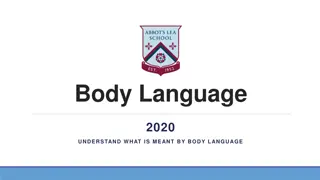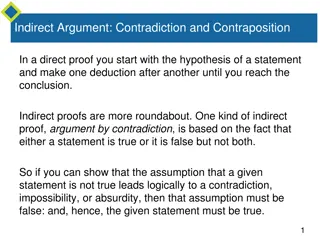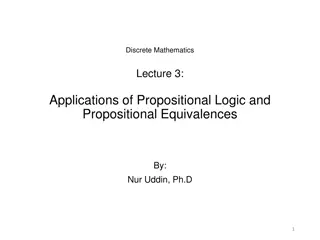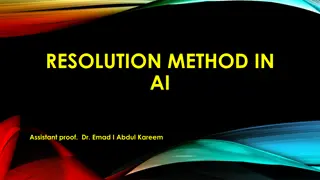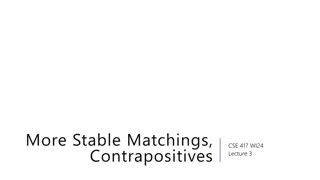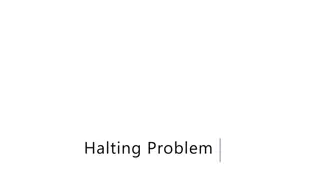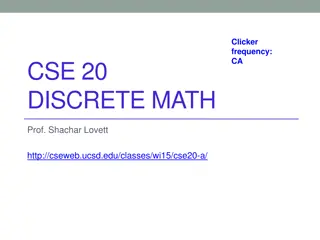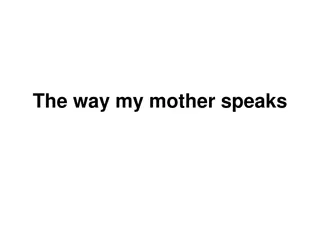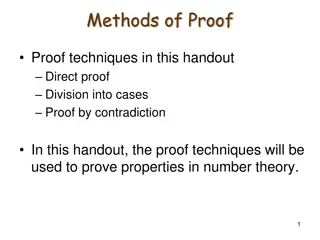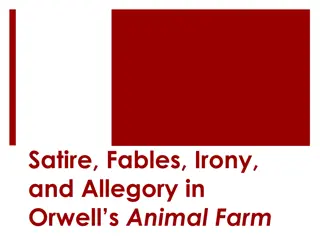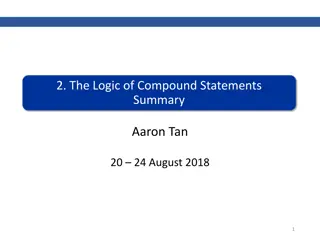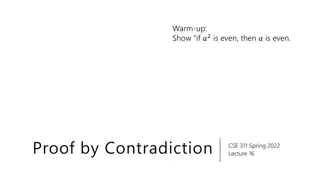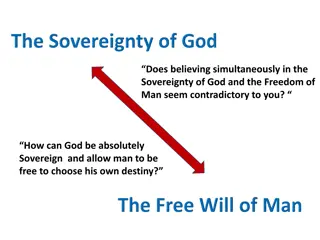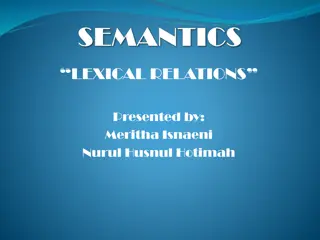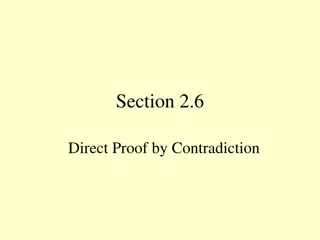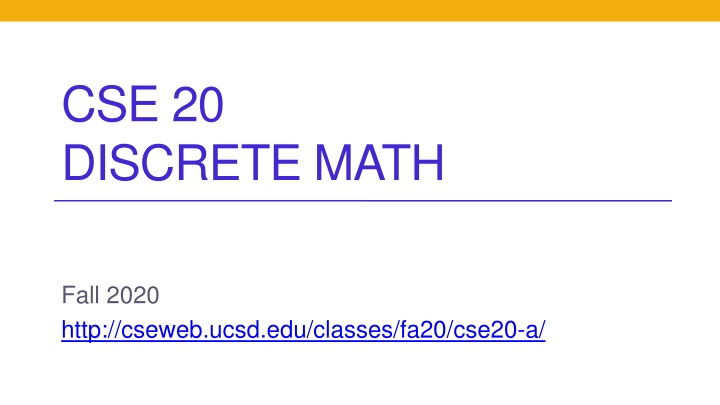
Discrete Math Fall 2020: Proof Techniques, Greatest Integer, Prime Numbers
Explore proof techniques in discrete math, including evaluating proof by contradiction, disproving existential claims, and analyzing the existence of greatest prime numbers. Understand the concepts of greatest integer, least integer, and more. Delve into the theorem that there is no greatest prime number through strategic reasoning and logical steps.
Uploaded on | 0 Views
Download Presentation

Please find below an Image/Link to download the presentation.
The content on the website is provided AS IS for your information and personal use only. It may not be sold, licensed, or shared on other websites without obtaining consent from the author. If you encounter any issues during the download, it is possible that the publisher has removed the file from their server.
You are allowed to download the files provided on this website for personal or commercial use, subject to the condition that they are used lawfully. All files are the property of their respective owners.
The content on the website is provided AS IS for your information and personal use only. It may not be sold, licensed, or shared on other websites without obtaining consent from the author.
E N D
Presentation Transcript
CSE 20 DISCRETE MATH Fall 2020 http://cseweb.ucsd.edu/classes/fa20/cse20-a/
Learning goals Today s goals Evaluate which proof technique(s) is appropriate for a given proposition Trace and/or construct a proof by contradiction
Greatest and least A. There is a greatest integer B. There is a least integer C. There is a greatest prime number D. There is a least prime number E. More than one of the above
Two approaches Goal: Disprove an existential claim Approach 1: Prove the equivalent universal claim Approach 2: Proof by contradiction
Assume , that there is a greatest integer Scratch work Identifyr = there are two numbers that are each bigger than the other To show:
Two approaches Goal: Disprove an existential claim Approach 1: Prove the equivalent universal claim Approach 2: Proof by contradiction
Theorem: There is no greatest prime number. Assume , that there is a greatest prime number, call it nBIG. Chooser = Every positive integer greater than 1 is a product of primes. To show: We have proved that r is True. To show: r is False (under assumption).
Theorem: There is no greatest prime number. Assume , that there is a greatest prime number, call it nBIG. Chooser = Every positive integer greater than 1 is a product of primes. To show: We have proved that r is True. To show: r is False (under assumption). Idea: Use assumption to build a number that is not a product of primes
Theorem: There is no greatest prime number. Assume , that there is a greatest prime number, call it nBIG. Chooser = Every positive integer greater than 1 is a product of primes. To show: We have proved that r is True. To show: r is False (under assumption). We can name all primes (since there are finitely many integers between 2 and nBIG) n1, n2, , nBIG Consider the number C = (n1 n2 nBIG)+ 1. This is a positive integer greater than 1. Lemma: C does not have any prime factors and thus is not a product of primes.
Theorem: There is no greatest prime number. Assume , that there is a greatest prime number, call it nBIG. Chooser = Every positive integer greater than 1 is a product of primes. To show: We have proved that r is True. To show: r is False (under assumption). Lemma: There is an integer, C, that is not a product of primes. Since assuming that there is a greatest prime guarantees must be false.Thus, its negation is true. the assumption
Choosing a proof strategy When might it be appropriate to use induction? A. To prove that an existential claim is true B. To prove that a universal claim is false C. To prove that a conditional claim is true D. More than one of the above E. None of the above
Choosing a proof strategy When might it be appropriate to use proof by contradiction? A. To prove that an existential claim is true B. To prove that a universal claim is false C. To prove that a conditional claim is true D. More than one of the above E. None of the above
The square root of 2 Which of the following statements is not true about this number? A. It is a real number. B. It is strictly less than 2. C. It is strictly greater than 1. D. It is a solution to x2 2 = 0. E. It is even.
The square root of 2 Goal: The square root of 2 is not a rational number. Attempted proof: The definition of the set of rational numbers is the collection of fractions p/q where p is an integer and q is a nonzero integer. Looking for a witness p and q, we can write the square root of 2 as the fraction /1, where 1 is a nonzero integer. Since the numerator is not in the domain, this witness is not allowed, and we have shown that the square root of 2 is not a fraction of integers (with nonzero denominator). Thus, the square root of 2 is not rational.
The square root of 2 Goal: The square root of 2 is not a rational number. Attempted proof: Towards a proof by contradiction, we will define a statement r such that .<<fill in once we know what r should be>> .
The square root of 2 Goal: The square root of 2 is not a rational number. Attempted proof: Towards a proof by contradiction, we will define a statement r such that .<<fill in once we know what r should be>> .
Challenge: prove these lemmas. Hints: - - - Write numbers as products of primes Use definitions (of even, gcd) Use direct proof & proof by contrapositive for biconditional (see bonus video)
The square root of 2 Goal: The square root of 2 is not a rational number. Attempted proof: Towards a proof by contradiction, we will define a statement r such that In a direct proof of the conditional, we assume (positive) integers p, q with . Namely, there are Rewrite this fraction in lowest terms: divide p and q by greatest common divisor with gcd(a,b)=1.
The square root of 2 Goal: The square root of 2 is not a rational number. Attempted proof: Towards a proof by contradiction, . assuming square root of 2 is rational gives integers a, b with gcd(a,b)=1 and . By Lemma 2 a and b are not both even.
The square root of 2 Goal: The square root of 2 is not a rational number. Attempted proof: Towards a proof by contradiction, . assuming square root of 2 is rational gives integers a, b with gcd(a,b)=1 and . By Lemma 2 a and b are not both even. Squaring both sides and clearing denominator: 2b2 = a2 . By definition of even (since b2 is an integer), a2 is even.
The square root of 2 Goal: The square root of 2 is not a rational number. Attempted proof: Towards a proof by contradiction, . assuming square root of 2 is rational gives integers a, b with gcd(a,b)=1 and . By Lemma 2 a and b are not both even. Squaring both sides and clearing denominator: 2b2 = a2 . By definition of even (since b2 is an integer), a2 is even. By Lemma 3, this guarantees a is even too. By definition of even, there is some integer, call it c, such that a = 2c.
The square root of 2 Goal: The square root of 2 is not a rational number. Attempted proof: Towards a proof by contradiction, . assuming square root of 2 is rational gives integers a, b with gcd(a,b)=1 and . By Lemma 2 a and b are not both even . From definitions, a is even, so there is some integer, call it c, such that a = 2c. Plugging into equation relating a and b: 2b2 = a2 = (2c)2 = 4c2.
The square root of 2 Goal: The square root of 2 is not a rational number. Attempted proof: Towards a proof by contradiction, . assuming square root of 2 is rational gives integers a, b with gcd(a,b)=1 and . By Lemma 2 a and b are not both even . From definitions, a is even, so there is some integer, call it c, such that a = 2c. Plugging into equation relating a and b: 2b2 = a2 = (2c)2 = 4c2. Dividing both sides by two gives b2 = 2c2 , and since c2 is an integer, the definition of even means that b2 is even. Applying Lemma 3: b is even.
The square root of 2 Goal: The square root of 2 is not a rational number. Attempted proof: Towards a proof by contradiction, . assuming square root of 2 is rational gives integers a, b with gcd(a,b)=1 and . By Lemma 2 a and b are not both even . From definitions, a is even, so there is some integer, call it c, such that a = 2c. Plugging into equation relating a and b: 2b2 = a2 = (2c)2 = 4c2. Dividing both sides by two gives b2 = 2c2 , and since c2 is an integer, the definition of even means that b2 is even. Applying Lemma 3: b is even. Thus, a is even and b is even.
The square root of 2 Goal: The square root of 2 is not a rational number. Attempted Proof: Towards a proof by contradiction, we will define a statement r such that In a direct proof of the conditional, we assume (positive) integers p,q with . Namely, there are Rewrite this fraction in lowest terms: divide p and q by greatest common divisor with gcd(a,b)=1. Define r = it is not the case that both a is even and b is even By Lemma 2, r is true . By definitions, Lemma 2 and Lemma 3, r is false.
Recap Proof by contradiction can be useful in proving negations of existentials. In a proof by contradiction, we are proving a conditional claim where the hypothesis is the negation of the statement we are trying to prove and the conclusion is up to us to figure out!
For next time Reading for next time: Section 4.3 Example 2 Section (p. 258), Section 1.7 Example 9 (p. 86)

